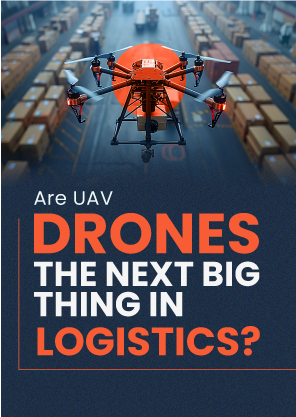or call: +1 (845) 347-8894

or call: +1 (845) 347-8894
or call: +1 (845) 347-8894

The global supply chains undergo a structural shift in the wake of the post-pandemic world. With escalating consumer demands and the need for superior customer experiences, efficiency, seamlessness, cost-effectiveness, and timeliness become pivotal. Anticipations like immediate deliveries prompt sellers and logistics entities to transcend traditional vehicle-centric networks.
The World Economic Forum (WEF) reports a staggering 85 million packages and documents delivered globally every day. Studies indicate that despite this massive volume, the last-mile delivery, constituting approximately 50% of total logistical expenses, remains the most time-consuming aspect.
In response to inefficiencies in last-mile logistics, an increasing number of logistics stakeholders are embracing drone technology. This innovative approach enables control over operational costs, circumvention of traffic bottlenecks, and curbing vehicular emissions, all while meeting the rising demand for immediate on-demand deliveries. Initially used primarily for military purposes, drones have now become instrumental in reshaping supply chains and logistics. Their applications span across warehouses, location technology, inspections, and surveys, revolutionizing various aspects of the industry.
The current regulations regarding drone operations in India are quite intricate. Despite the government’s push for drone technology, there are stringent guidelines set by the Directorate General of Civil Aviation (DGCA). Under India’s drone regulations:
These regulations significantly escalate operational costs and restrict the potential scope of drone applications. Furthermore, obtaining approvals from aviation authorities and government bodies can be a cumbersome process in India.
In its early stages, drone technology comes with a substantial price tag. The notion of unmanned aerial vehicles carrying valuable cargo hundreds of feet above ground raises concerns for insurance companies. The uncharted territory of such operations poses a challenge for insurers in assessing and determining premiums. Moreover, the potential for drones to cause personal injury, with compensation reaching millions, prompts insurance companies to set high premiums. Consequently, the overall expense of employing drone technology for deliveries rises significantly, surpassing the cost of traditional delivery methods.
Traditional delivery systems utilizing trucks and vans tend to handle Indian rainy weather quite capably, offering adequate protection against rain, wind, and other adverse conditions. However, the concern arises when considering how small drones in logistics will perform in harsh weather. Inclement weather not only poses a risk to the drone itself but also jeopardizes the safety of the packages they carry. India, with its diverse seasonal patterns and occasional adverse weather, presents a challenge for drone technology. The pivotal issue remains: can drones operate solely under optimal weather, which in India’s context, is often unpredictable and unreliable?
Autonomous operation sets drones apart, liberating them from the constraints of traffic congestion and typical logistical hurdles encountered by conventional delivery vehicles. This autonomy paves the way for streamlined and more efficient delivery routes, culminating in expedited package delivery. By circumventing traffic delays and navigating with precision, drones optimize the delivery process, significantly truncating the time required for packages to reach their destinations. Free from the constraints of conventional roadways, these aerial vehicles redefine efficiency in logistics, offering a seamless and prompt delivery experience.
Drones in logistics epitomize swifter order fulfillment, boasting unparalleled speed compared to traditional ground or air methods. This advancement addresses retailers’ pivotal challenge of meeting escalating consumer demands for rapid order completion—a fundamental expectation in today’s AI digital era. The expedited pace of drone delivery not only aligns with these consumer expectations but also underscores its potential to reshape the logistics landscape. Retailers leveraging this technology are positioned to not just meet but exceed consumer demands for prompt order fulfillment, establishing a competitive edge in a market where speed is paramount.
Investing in drone technology initially may pose costs, yet retailers stand to gain long-term savings by lessening reliance on human delivery drivers and their accompanying labor expenses. Drones, unlike their human counterparts, operate tirelessly, 24/7, without requiring breaks or rest periods. This autonomy translates into significant operational efficiencies, potentially diminishing the need for human labor, thereby curbing associated expenses over time. The initial investment outlay pales in comparison to the sustained cost reductions and enhanced operational capabilities that drones offer. Ultimately, embracing drone technology empowers retailers to streamline delivery operations, leveraging the perpetual availability and efficiency of these autonomous aerial vehicles for sustainable, cost-effective delivery services this is the reason that makes drones cost-effective autonomous cars or delivery trucks
Drones in logistics stand as an environmentally conscientious alternative to conventional methods reliant on fossil fuels. Electrically powered drones significantly diminish emissions, rendering them a greener choice for last-mile deliveries. By eschewing traditional fuel sources, these drones offer a sustainable solution, contributing to reduced environmental impact. Their operation aligns with eco-friendly practices, emitting fewer pollutants in contrast to vehicles reliant on fossil fuels. In navigating the last leg of deliveries, electric drones emerge as a pivotal means to mitigate environmental strain, symbolizing a shift toward more sustainable logistics practices.
In the evolving logistics landscape post-pandemic, drones promise enhanced efficiency and speed, addressing the pressing need for faster deliveries and superior customer experiences. However, challenges like stringent regulations, high costs, and weather constraints hinder their seamless integration. Despite these obstacles, drones offer unparalleled benefits: optimized efficiency, swifter deliveries, potential cost savings, and a lighter environmental footprint. Their autonomous operation revolutionizes last-mile logistics, streamlining deliveries and minimizing environmental impact. While obstacles persist, the transformative potential of drones in logistics remains promising, redefining the future of supply chains worldwide.
